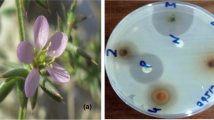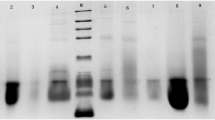Abstract
Natural peptides are emerging as a leading alternative to conventional drugs and antibiotics, owing to their remarkable potency, better stability and less toxicity. Such peptides encompass numerous healing properties such as antimicrobial, anti-inflammatory, immunomodulatory, etc. Though plant- derived peptides have been widely studied for their therapeutic benefits, however, fungal peptides are still lesser explored. Ganoderma lucidum, a highly medicinal oriental mushroom comprises a vast array of phytoconstituents, namely flavonoids, phenolics, terpenoids, polysaccharides, proteins, glycolipids, etc and hence, is being used since several decades in traditional Chinese medicine (TCM) for its various ameliorative effects e.g. anti-inflammatory, antimicrobial, anti-proliferative and antioxidant properties. This study presents the isolation and characterization of antibacterial peptide fractions from fruiting body (GLF) and mycelium (GLM) of Indian G. lucidum. Representative amide bonds were identified in the fractions using established standard techniques. Peptide mass fingerprinting and HPLC confirmed the presence of cationic and hydrophobic amino acids in the peptide fractions which are known to be major structural features of antimicrobial peptides. Secondary structure prediction showed abundance of α-helices and random coils in GLF and GLM fractions respectively. The fractions exhibited appreciable antioxidant potential. Besides, these also possessed substantial antibacterial activity against Escherichia coli and Salmonella typhi wherein it was observed that generation of reactive oxygen species and induction of intracellular protein leakage within the bacterial cells were the possible mechanisms of inhibitory action.









Similar content being viewed by others
References
Abbaspour N, Hurrell R, Kelishadi R (2014) Review on iron and its importance for human health. J Res Med Sci 19:164–174
Akabanda F, Owusu-Kwarteng J, Tano-Debrah K, Parkouda C, Jespersen L (2014) The use of lactic acid bacteria starter culture in the production of Nunu, a spontaneously fermented milk product in Ghana. Int J Food Sci doi. https://doi.org/10.1155/2014/721067
Anantharaman A, Hemachandran H, Mohan S, Ayyathan DM, Siva R (2016) Induction of apoptosis by apocarotenoids in B16 melanoma cells through ROS-mediated mitochondrial-dependent pathway. J Funct Foods 20:346–357
Bhardwaj A, Pal M, Srivastava M, Tulsawani R, Sugadev R, Misra K (2015) HPTLC based chemometrics of medicinal mushrooms. J Liq Chromatogr Relat Technol 38:1392–1406
Bhardwaj A, Gupta P, Kumar N, Mishra J, Kumar A, Rajput R, Misra K (2017) Lingzhi or Reishi Medicinal Mushroom, Ganoderma lucidum (Agaricomycetes) Inhibits Candida Biofilms: a metabolomic Approach. Int J Med Mushrooms. https://doi.org/10.1615/IntJMedMushrooms.2017021225
Brand-Williams W, Cuvelier ME, Berset C (1995) Use of a free radical method to evaluate antioxidant activity. Food Sci Technol 28:25–30
Coughlan MP (1983) The role of molybdenum in human biology. J Inherit Metab Dis 6:70–77
Dinis TC, Madeira VM, Almeida LM (1994) Action of phenolic derivatives (acetaminophen, salicylate, and 5-aminosalicylate) as inhibitors of membrane lipid peroxidation and as peroxyl radical scavengers. Arch Biochem Biophys 315:161–169
Dwyer DJ, Camacho DM, Kohanski MA, Callura JM, Collins JJ (2012) Antibiotic-induced bacterial cell death exhibits physiological and biochemical hallmarks of apoptosis. Mol Cell 46:561–572
Elias RJ, Kellerby SS, Decker EA (2008) Antioxidant activity of proteins and peptides. Crit Rev Food Sci Nutr 48:430–441
Fabian H, Mäntele W (2002) Infrared spectroscopy of proteins. In: Handbook of vibrational spectroscopy, Wiley Online library
Gao Q, ** K, Ying SH, Zhang Y, **ao G, Shang Y, Duan Z, Hu X, **e XQ, Zhou G, Peng G (2011) Genome sequencing and comparative transcriptomics of the model entomopathogenic fungi Metarhizium anisopliae and M. acridum. PLoS Genet 7(1):e1001264
Ge M, Li B, Wang L, Tao Z, Mao S, Wang Y, **e G, Sun G (2014) Differentiation in MALDI-TOF MS and FTIR spectra between two pathovars of Xanthomonas oryzae. Spectrochim Acta Mol Biomol Spectrosc 133:730–734
Giebel R, Worden C, Rust SM, Kleinheinz GT, Robbins M, Sandrin TR (2010) Microbial fingerprinting using matrix-assisted laser desorption ionization time-of-flight mass spectrometry (MALDI-TOF MS): applications and challenges. Adv Appl Microbiol 71:149–184
Girjal VU, Neelagund S, Krishnappa M (2012) Antioxidant properties of the peptides isolated from Ganoderma lucidum fruiting body. Int J Pept Res Ther 18:319–325
Gopal R, Park JS, Seo CH, Park Y (2012) Applications of circular dichroism for structural analysis of gelatin and antimicrobial peptides. Int J Mol Sci 13:3229–3244
Greenfield NJ (2006) Using circular dichroism spectra to estimate protein secondary structure. Nat Protoc 1:2876–2890
Hacquard S, Kracher B, Hiruma K, Münch PC, Garrido-Oter R, Thon MR, Weimann A, Damm U, Dallery JF, Hainaut M, Henrissat B (2016) Survival trade-offs in plant roots during colonization by closely related beneficial and pathogenic fungi. Nat Commun 7:11362
Jacobsen NE (2016) NMR data interpretation explained: understanding 1D and 2D NMR spectra of organic compounds and natural products. Wiley
Jiang N, Tan NS, Ho B, Ding JL (2007) Respiratory protein-generated reactive oxygen species as an antimicrobial strategy. Nat Immunol 8:1114–1122
Kinter M, Sherman NE (2005) Protein sequencing and identification using tandem mass spectrometry. Wiley
Mamat C, Pretze M, Gott M, Köckerling M (2016) Synthesis, dynamic NMR characterization and XRD studies of novel N,N′-substituted piperazines for bio orthogonal labeling. Beilstein J Org Chem 12:2478–2489
Martin E, Ganz T, Lehrer RI (1995) Defensins and other endogenous peptide antibiotics of vertebrates. J Leuk Biol 58:121–136
Mishra K, Ojha H, Chaudhury NK (2012) Estimation of antiradical properties of antioxidants using DPPH assay: a critical review and results. Food Chem 130:1036–1043
Murasugi A, Tanaka S, Komiyama N, Iwata N, Kino K, Tsunoo H, Sakuma S (1991) Molecular cloning of a cDNA and a gene encoding an immunomodulatory protein, Ling Zhi-8, from a fungus, Ganoderma lucidum. J Biol Chem 266:2486–2493
National Committee for Clinical Laboratory Standards (1997) Performance standards for antimicrobial disk susceptibility tests. Approved standard M2-A6 Wayne
Prieto P, Pineda M, Anguilar M (1999) Spectrophotometric quantitation of antioxidant capacity through the formation of a phosphomolybdenum complex: specific application to the determination of Vitamin E. Anal Biochem 269:337–341
Schaller HC, Bodenmüller H (1981) Isolation and amino acid sequence of a morphogenetic peptide from hydra. Proc Natl Acad Sci USA 78:7000–7004
Shalaby EA, Shanab SM (2013) Antiradical and antioxidant activities of different Spirulina platensis extracts against DPPH and ABTS radical assays. J Mar Biol Oceanogr 2:1–8
Sharma P, Suryakumar G, Singh V, Misra K, Singh SB (2015) In vitro antioxidant profiling of seabuckthorn varieties and their adaptogenic response to high altitude-induced stress. Int J Biometeorol 59:1115–1126
Sun J, He H, **e BJ (2004) Novel antioxidant peptides from fermented mushroom Ganoderma lucidum. J Agric Food Chem 52:6646–6652
Tang QL, Kang AR, Lu CX (2016) Phytochemical analysis, antibacterial activity and mode of action of the methanolic extract of Scutellaria barbata against various clinically important bacterial pathogens. Int J Pharm 12:116–125
Wang H, Ng TB (2006) Ganodermin, an antifungal protein from fruiting bodies of the medicinal mushroom Ganoderma lucidum. Peptides 27:27–30
Wang SY, Hsu ML, Hsu HC, Lee SS, Shiao MS, Ho CK (1997) The anti-tumor effect of Ganoderma lucidum is mediated by cytokines released from activated macrophages and T. lymphocytes. Int J Cancer 70:699–705
Wasser SP (2005) Reishi or Ling Zhi (Ganoderma lucidum). In: Encyclopedia of dietary supplements. 1, 603–622
White JA, Hart RJ, Fry JC (1986) An evaluation of the Waters Pico-Tag system for the amino-acid analysis of food materials. J Anal Met Chem 8:170–177
Xu Z, Chen X, Zhong Z, Chen L, Wang Y (2011) Ganoderma lucidum polysaccharides: immunomodulation and potential anti-tumor activities. Am J Chin Med 39:15–27
Yoneyama F, Imura Y, Ohno K, Zendo T, Nakayama J, Matsuzaki K, Sonomoto K (2009) Peptide-lipid huge toroidal pore, a new antimicrobial mechanism mediated by a lactococcal bacteriocin, lacticin Q. Antimicrob Agents Chemother 53:3211–3217
Yu J, Lei J, Yu H, Cai X, Zou G (2004) Chemical composition and antimicrobial activity of the essential oil of Scutellaria barbata. Phytochemistry 65:881–884
Zhang L, Xu SG, Liang W, Mei J, Di YY, Lan HH, Yang Y, Wang WW, Luo YY, Wang HZ (2015) Antibacterial activity and mode of action of Mentha arvensis ethanol extract against multidrug-resistant Acinetobacter baumannii. Trop J Pharm Res 14:2099–2106
Acknowledgements
The authors would like to express their gratitude to the Director, DIPAS for his constant support and encouragement. The authors would also extend their thanks to Advanced Research Facility, Jawaharlal Nehru University, Delhi and Department of Chemistry, Delhi University for providing analytical support. Two of the authors Miss Jigni Mishra and Miss Rakhee would like to thank Defence Research and Development Organization, India and Council for Scientific and Industrial Research, India, respectively, for doctoral fellowships.
Author information
Authors and Affiliations
Corresponding author
Ethics declarations
Conflict of interest
There is no conflict of interest from any of the authors.
Ethical Approval
This article does not contain any studies with human participants or animals performed by any of the authors.
Rights and permissions
About this article
Cite this article
Mishra, J., Rajput, R., Singh, K. et al. Antibacterial Natural Peptide Fractions from Indian Ganoderma lucidum . Int J Pept Res Ther 24, 543–554 (2018). https://doi.org/10.1007/s10989-017-9643-z
Accepted:
Published:
Issue Date:
DOI: https://doi.org/10.1007/s10989-017-9643-z




